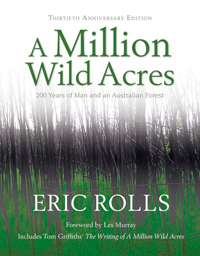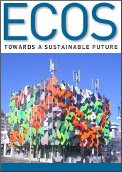
|
Published: 8 August 2011
A Million Wild Acres thirty years on
One of the twentieth century’s most widely read books on the Australian landscape, A Million Wild Acres by Eric Rolls, has been republished to mark 30 years since its first edition.

|
|
A Million Wild Acres: 200 Years of Man and an Australian Forest (Commemorative 30th Anniversary Edition) Eric Rolls Pan Macmillan Australia $34.95 ISBN: 9780868064642 |
The book is about settlement and life in inland New South Wales, from the arrival of the First Fleet until the 1980s. It depicts the dynamics of life, government and landscapes.
More specifically, the book highlights conflict and reconciliation between European settlers and Aborigines, the role of legislation on land management practice, the importance of developments in machinery, plant and animal breeding on primary production, and landscape changes invoked by humans and the natural elements of fire, drought and flood.
A Million Wild Acres is more than just a historical account of the movement west and northwards of settlers from Sydney Town towards the Pilliga Scrub; the author also brings to life those who played a role in opening up the country for Europeans.
Many of those who were instrumental in developing Australia’s livestock and cropping industries were not originally ‘men of the land’; they included aristocrats, convicts, bureaucrats, unskilled people, explorers and just plain hard workers, along with a fair share of exploiters, shirkers and villains. This diversity led to many tales of drama and intrigue.
Most will know that John Macarthur was the ‘father’ of the Australian wool industry, for example. However, it is less well known that he was to be court-martialled – in the end not undertaken – because of alleged violence; and his wife, Elizabeth, took charge of operating his grazing properties during his many absences in England. According to the author, ‘Without Elizabeth, Macarthur would have been nothing’!
The book uses the Pilliga forest as the example of what has happened after settlement elsewhere in Australia, particularly concerning the approaches to land management taken by authorities, which the author considers as generally inappropriate.
A Million Wild Acres is a readable layman’s account of Australian settlement and landscape responses. As an added advantage, the attention of the scientific reader will be maintained by the author’s use of scientific nomenclature and pertinent references to the dynamic response of landscapes to varied stimuli.
While presented in an interesting way, this reviewer found that the referrals to a large number of specific people and events impeded the historical flow. Nevertheless, these same comments and discussion add richness and authenticity. They also add flavor and colour to the life of the time – whether 1802, 1902 or 1972 – and illustrate the difficulties experienced by settlers and landholders even now.
Add the vagaries of weather to the mix, and it is clear that life in the bush has never been easy. Eric Rolls has captured this life in a unique way and has added his own perspective to where things could be improved, as well as his views on how landscapes develop in response to human and natural stimuli. He is adamant, for example, that what were called forests in the early days of settlement were in fact woodlands of three or four large trees per hectare, and that much of the present day ‘forest’ has grown since Europeans arrived in Australia.
The book’s foreword is an excerpt of Les Murray’s 1982 essay ‘Eric Rolls and the Golden Disobedience’, and Tom Griffith’s ‘The writing of A Million Wild Acres’ completes a preface that gives insightful comments on Rolls and his book.
At $34.95, the book makes a good buy, and it will add value to anyone’s book shelf – especially those who now live in ‘the bush’ and those who want to know ‘how the west was won’.



